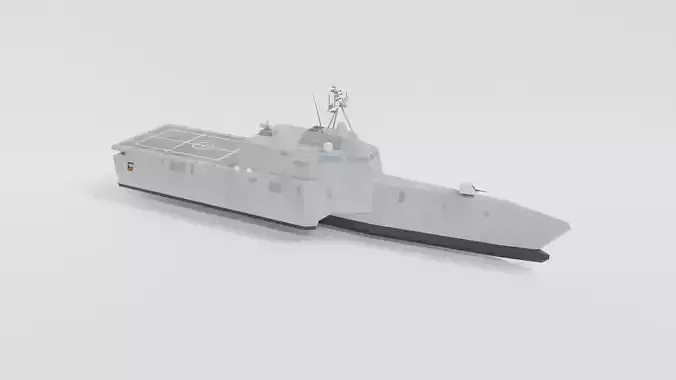1/24
USS Independence (LCS-2) is the lead ship of the Independence-class of littoral combat ships. She is the sixth ship of the United States Navy to be named for the concept of independence. The design was produced by the General Dynamics consortium for the Navy's LCS program, and competes with the Lockheed Martin designed Freedom variant.
Independence, delivered to the Navy at the end of 2009, is a high speed, small crew corvette (although the U.S. Navy does not use the term) intended for operation in the littoral zone. She can swap out various systems to take on various missions, including finding and destroying mines, hunting submarines in and near shallow water, and fighting small boats (she is not intended to fight warships). The ship is a trimaran design with a wide beam above the waterline that supports a larger flight deck than those of the Navy's much larger destroyers and cruisers, as well as a large hangar and a similarly large mission bay below. The trimaran hull also exhibits low hydrodynamic drag, allowing efficient operation on two diesel powered water jets at speeds up to 18 knots (33 km/h; 21 mph), and high speed operation on two gas turbine powered water jets at a sustainable 44 knots (81 km/h; 51 mph) and even faster for short periods.
On 20 June 2020, the US Navy announced that they would be taking Independence out of commission in March 2021, and placing her, along with Freedom, Fort Worth, and Coronado in reserve. Her decommissioning was pushed back to 31 July 2021.
The design for Independence is based on a high speed trimaran (Benchijigua Express) hull built by Austal (Henderson, Australia). The 418 feet (127 m) surface combatant design requires a crew of 43 sailors.
With 11,000 cubic metres (390,000 cu ft) of payload volume, she was designed to carry two mission modules, allowing the ship to do multiple missions without having to be refitted. The flight deck, 1,030 m2 (11,100 sq ft), can support two SH-60 Seahawk helicopters, multiple UAVs, or one CH-53 Sea Stallion-class helicopter. The trimaran hull will allow flight operations up to sea state 5.
Independence carries a default armament for self-defense, and command and control. Unlike traditional combatants with fixed armament such as guns and missiles, tailored mission modules can be configured for one mission package at a time. Modules may consist of manned aircraft, unmanned vehicles, off board sensors, or mission manning detachments.
The interior volume and payload is greater than some destroyers, allowing the ship to serve as a high speed transport and maneuver platform. The 15,200 square feet (1,410 m2) mission bay takes up most of the deck below the hangar and flight deck.
In addition to cargo or container sized mission modules, the bay can carry four lanes of multiple Strykers, armored Humvees, and their associated troops. An elevator allows air transport of packages the size of a 20-foot-long (6.1 m) shipping container that can be moved into the mission bay while at sea. A side access ramp allows for vehicle roll-on/roll-off loading to a dock and would have allowed the ship to transport the cancelled Expeditionary Fighting Vehicle.
Bunks and living spaces are below the bridge. The helm is controlled by joysticks instead of a traditional steering wheel.
Independence also has an integrated LOS Mast, Sea Giraffe 3D radar and SeaStar Safire FLIR. Side and forward surfaces are angled to reduce the ship's radar profile. In addition, H-60-series helicopters provide airlift, rescue, anti-submarine, radar picket and anti-ship capabilities with torpedoes and missiles.
The Raytheon Evolved SeaRAM missile defense system is installed on the hangar roof. The SeaRAM combines the sensors of the Phalanx 1B close in weapon system with an eleven missile launcher for the Rolling Airframe Missile (RAM), creating an autonomous system.
Northrop Grumman has demonstrated sensor fusion of on and off board systems in the Integrated Combat Management System (ICMS) used on Independence.
Independence has an Interior Communications Center that can be curtained off from the rest of bridge, instead of the heavily protected Combat Information Center found on other Navy warships.
Austal claims that Independence will use one-third less fuel than Freedom, but the Congressional Budget Office found that fuel would account for 18 percent or less of the total lifetime cost of Freedom. While it was unable to judge the fuel usage of Independence, the higher purchase price of Independence would dominate her lifetime costs.
Texture available on 4K.
ready to use in game or animation.
Available formats:
OBJ(mesh only)
DAE(mesh and materials)
FBX(mesh and materials)
BLEND(mesh and materials)
glTF
ENJOY
REVIEWS & COMMENTS
accuracy, and usability.
























